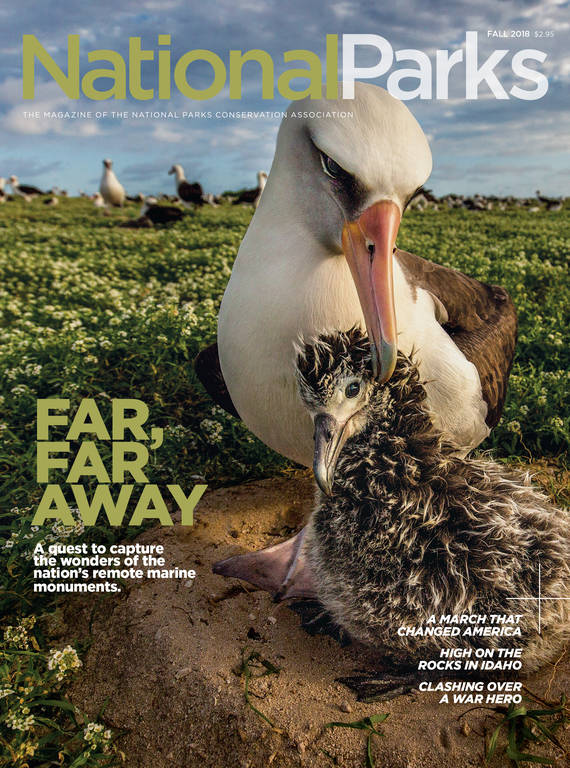Fall 2018
Rolling Stones
Using science to protect visitors from Yosemite’s falling rocks.
On September 27, 2017, a chunk of rock dropped from the face of Yosemite National Park’s El Capitan and tumbled 1,750 feet to the valley below.
Most of the dozens of climbers in the area escaped injury, but two climbers walking along the base of the cliffs were in the path of the debris. One was killed and the other seriously injured. The next day, a rock slab 20 times larger — weighing almost 28,000 tons or about 1,400 dump truck loads — crashed down. Remarkably, no one was killed, but one driver was hurt by a fragment that punctured his car’s sunroof and hit his head. At the time, Yosemite’s geologist, Greg Stock, was a couple of miles away. “Within minutes, there was a huge dust cloud sweeping up the valley,” he recounted. “I knew immediately what had happened.”
Rockfalls occur about once a week in Yosemite Valley, where they have caused 16 fatalities and more than 100 injuries since documentation began 150 years ago. The National Park Service is responsible for keeping visitors safe, but knowing where and when the next rock will fall is virtually unimaginable. Or is it? What used to be a far-fetched idea is starting to take shape. Scientists can now identify areas where risk is highest. Park managers in turn use the information to relocate park buildings and close roads to help keep visitors and staff out of harm’s way.
Stock and his team are using high-resolution photos of Yosemite’s cliffs and laser technology to create 3D images of fracture zones and rockfall debris. They run computer models to simulate the trajectory of falling rocks, and they analyze boulders’ exposure to cosmic rays to figure out the frequency of ancient rockfalls. They’ve also cataloged more than 1,000 past rockfalls, which are one of the best indicators of future events. “A data set like this is really precious and hard to come by,” said Jeff Moore, assistant professor of geology and geophysics at the University of Utah. “The research that Stock is doing is at the forefront of rockfall science.”
Yosemite Valley is an ideal place to study rockfall in part because of its glacial history. When ice retreated 15,000 years ago, it left behind a flat-bottomed valley flanked by vertical sides. High granite walls, no longer supported by ice, began to drop rocks in sometimes stupendous volumes. Occasionally, rockfalls are large enough to generate category 5 hurricane-strength winds and obliterate thousands of trees.
“Rockfalls are really loud,” said Stock, who has worked at Yosemite since 2006. “They sound a lot like thunder, and you can often hear individual rocks hitting and breaking and bouncing around. Then you hear the sound of trees being knocked over and vegetation being pulverized. These are really intense events.”
Rockfalls occur for a variety of reasons: Roots can pry apart rocks, and water widens cracks through freezing, thawing and weathering. Once a section of a cliff is cracked, earthquakes, heat and rainstorms can jolt the unstable area and send granite slabs tumbling down at tremendous speed. When the dust settles, wedge-shaped heaps of debris are left at the base of the cliff.
Though rockfalls pose a danger to visitors, Stock points out that the park is far safer than the freeways and cities nearby. “The chance of seeing or being affected by a rockfall is really, really tiny,” he said. Even a tiny chance can end in tragedy, however, and the Park Service and the U.S. Geological Survey decided to intensify their research after a rockfall killed three hikers and injured 19 on the upper Yosemite Falls Trail in 1980.
Scientists have recorded rockfall events dating back to 1857 into a database. To go farther back in time, they turn to boulders strewn across the valley floor. Using cosmogenic exposure dating, a method that analyzes rare isotopes resulting from exposure to cosmic rays, they can find out when a particular rock fell. This crucial information helps determine the hazard for a given area based on the frequency of past rockfalls. “Exposure dating allows us to probe into the geologic record,” Moore said. “We can ask the question how often huge events are happening.”
In 2012, Stock and his team completed a comprehensive report that assessed where rockfalls were likely to occur and overlaid the hazard zones onto a map of the park’s infrastructure. Based on the report, park staff moved 200 buildings and campsites, many of them in Half Dome Village. These decisions reduced rockfall risk in the valley by an estimated 95 percent and narrowly avoided disaster when a rockfall pummeled Half Dome Village the next year. One boulder landed on the footprint of a cabin that had just been moved.
Outside the park, rockfall hazards are mitigated by rock bolts, concrete sprayed on the cliffs, containment nets or even the removal of dangerous rocks, but these approaches are incompatible with the park’s mission. “Rockfall is a natural process,” Stock said. “We’re charged with allowing those processes to prevail.”
To establish a baseline, scientists created a highly detailed panoramic image of Yosemite Valley’s walls. The massive photo spans the entire valley and stitches together hundreds of images shot from several locations. One of the largest in the world, this billion-pixel mosaic allows geologists to spot cracks in the cliffs that could lead to rockfalls. The panorama also is used by biologists searching for peregrine falcon nests, climbers planning new routes, and search and rescue operations.
The giant image, when combined with a digital terrain model produced by LiDAR (Light Detection and Ranging), yields a precise 3D perspective of the valley and the hazard zones. The team gathers LiDAR data by sending laser pulses from an airplane or ground station to the cliffs and recording the reflected light. This is the same technology used by driverless cars to gauge distance from objects. “We’re mapping with light,” Stock said.

National Parks
You can read this and other stories about history, nature, culture, art, conservation, travel, science and more in National Parks magazine. Your tax-deductible membership donation of $25 or more entitles…
See more ›After each rockfall, Stock takes new photos of the cliffs. Within 24 hours of the El Capitan incidents, he and his colleagues had pinpointed the source and calculated the volume of fallen rock by taking high-resolution photos from a helicopter and updating 3D computer models. In almost real time, they evaluated the possibility of an even larger rockfall and advised park officials on road closures. The El Capitan falls were not a complete surprise to Stock because the area was well within the hazard zone, but such information unfortunately is not sufficient to anticipate the timing of rockfalls.
Perhaps Stock’s most important tool is computer software that helps him simulate the trajectory of falling rocks. That program can’t predict the timing of a potential rockfall either, but it helps scientists figure out where rocks would end up if a rockfall were to take place in a given location and whether infrastructure or people might be at risk.
The ultimate goal, of course, is to know both where and when rockfalls will happen before they actually occur. The “when” is still within the realm of science fiction, but that could change. “I’m not going to say it’s totally impossible,” Stock said. “I hold out some hope that maybe it’ll happen in my lifetime.”
About the author
-
 Emily Mount Contributor
Emily Mount ContributorEmily Mount worked as a national park ranger at 10 national parks across the West. Today she is a naturalist and photography instructor for Lindblad Expeditions/National Geographic and a freelance environmental writer and photographer.



